2205NSC Calculus II: Assignment 1 Solution, Griffith University
VerifiedAdded on 2023/06/12
|9
|1753
|180
Homework Assignment
AI Summary
This document presents the solution to a Calculus II assignment, likely for the 2205NSC course at Griffith University. It includes detailed solutions to five questions covering topics such as line integrals, Green's Theorem, fluid flow, curl of a vector field, and Laplace transforms. The first question calculates the work done by a force field along a circular path. The second question applies Green's Theorem to calculate the circulation of a vector field. The third question determines the total fluid outflow through a unit cube. The fourth question calculates the curl of a vector field and verifies that the divergence of the curl is zero. Finally, the fifth question solves a second-order differential equation using Laplace transforms, determining y(t).
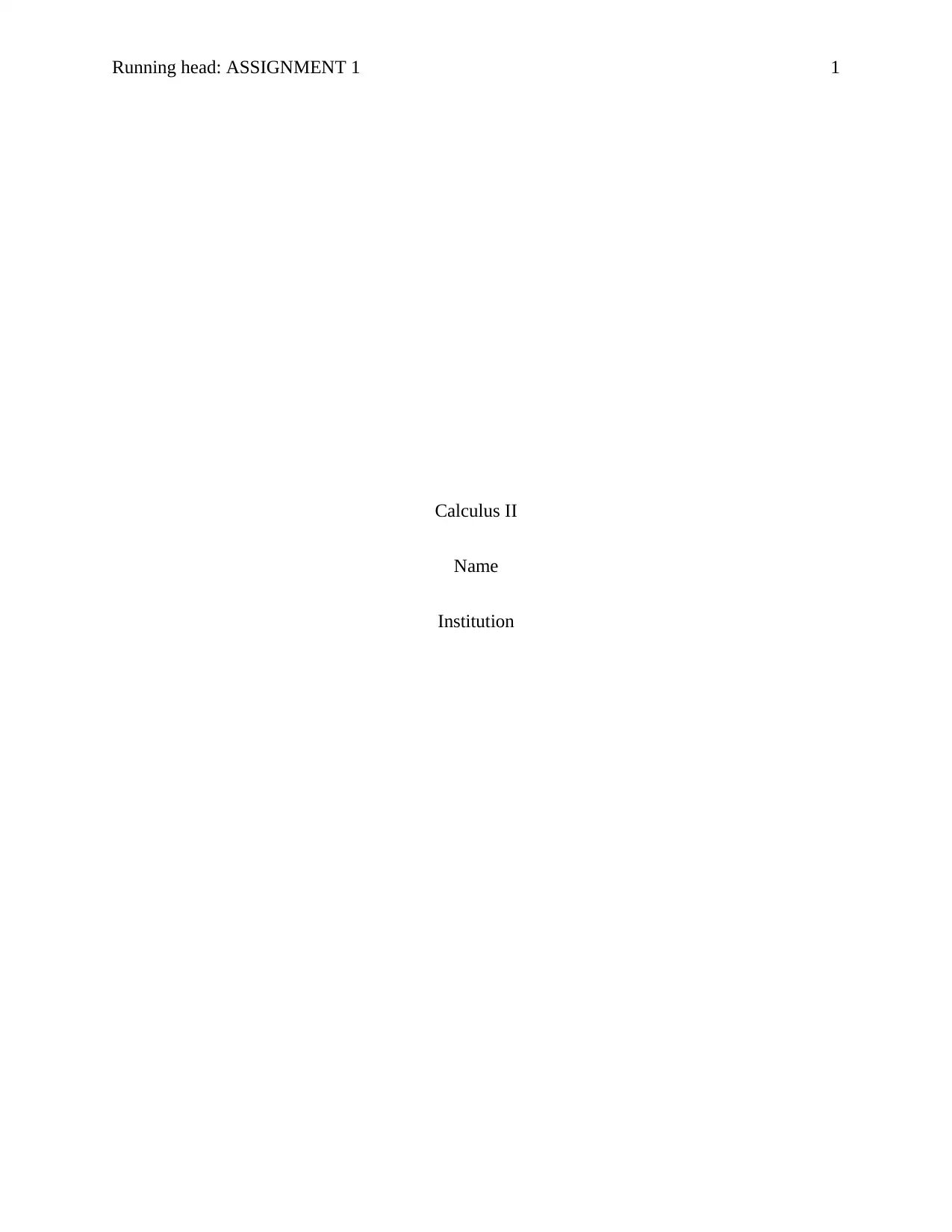
Running head: ASSIGNMENT 1 1
Calculus II
Name
Institution
Calculus II
Name
Institution
Paraphrase This Document
Need a fresh take? Get an instant paraphrase of this document with our AI Paraphraser
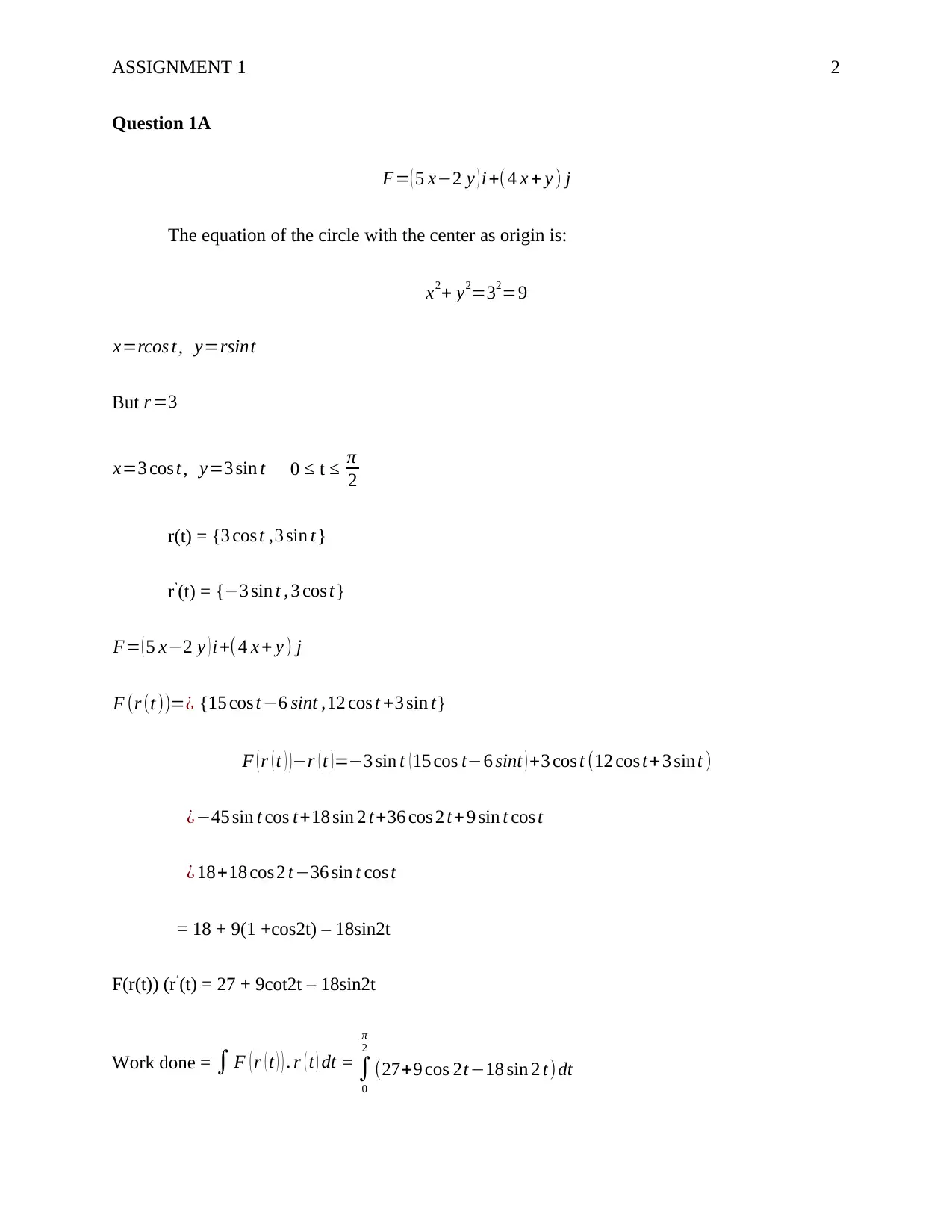
ASSIGNMENT 1 2
Question 1A
F= ( 5 x−2 y ) i+( 4 x + y ) j
The equation of the circle with the center as origin is:
x2+ y2=32=9
x=rcos t, y=rsint
But r =3
x=3 cos t , y=3 sin t 0 ≤ t ≤ π
2
r(t) = {3 cos t ,3 sin t}
r’(t) = {−3 sin t , 3 cos t}
F= ( 5 x−2 y ) i +( 4 x + y ) j
F (r (t ))=¿ {15 cos t−6 sint ,12 cos t +3 sin t}
F ( r ( t ) )−r ( t )=−3 sin t (15 cos t−6 sint ) +3 cos t (12 cos t+ 3 sint )
¿−45 sin t cos t+18 sin 2 t+36 cos 2 t+ 9 sin t cos t
¿ 18+18 cos 2 t −36 sin t cos t
= 18 + 9(1 +cos2t) – 18sin2t
F(r(t)) (r’(t) = 27 + 9cot2t – 18sin2t
Work done = ∫ F ( r ( t ) ) . r ( t ) dt = ∫
0
π
2
(27+9 cos 2t−18 sin 2 t )dt
Question 1A
F= ( 5 x−2 y ) i+( 4 x + y ) j
The equation of the circle with the center as origin is:
x2+ y2=32=9
x=rcos t, y=rsint
But r =3
x=3 cos t , y=3 sin t 0 ≤ t ≤ π
2
r(t) = {3 cos t ,3 sin t}
r’(t) = {−3 sin t , 3 cos t}
F= ( 5 x−2 y ) i +( 4 x + y ) j
F (r (t ))=¿ {15 cos t−6 sint ,12 cos t +3 sin t}
F ( r ( t ) )−r ( t )=−3 sin t (15 cos t−6 sint ) +3 cos t (12 cos t+ 3 sint )
¿−45 sin t cos t+18 sin 2 t+36 cos 2 t+ 9 sin t cos t
¿ 18+18 cos 2 t −36 sin t cos t
= 18 + 9(1 +cos2t) – 18sin2t
F(r(t)) (r’(t) = 27 + 9cot2t – 18sin2t
Work done = ∫ F ( r ( t ) ) . r ( t ) dt = ∫
0
π
2
(27+9 cos 2t−18 sin 2 t )dt
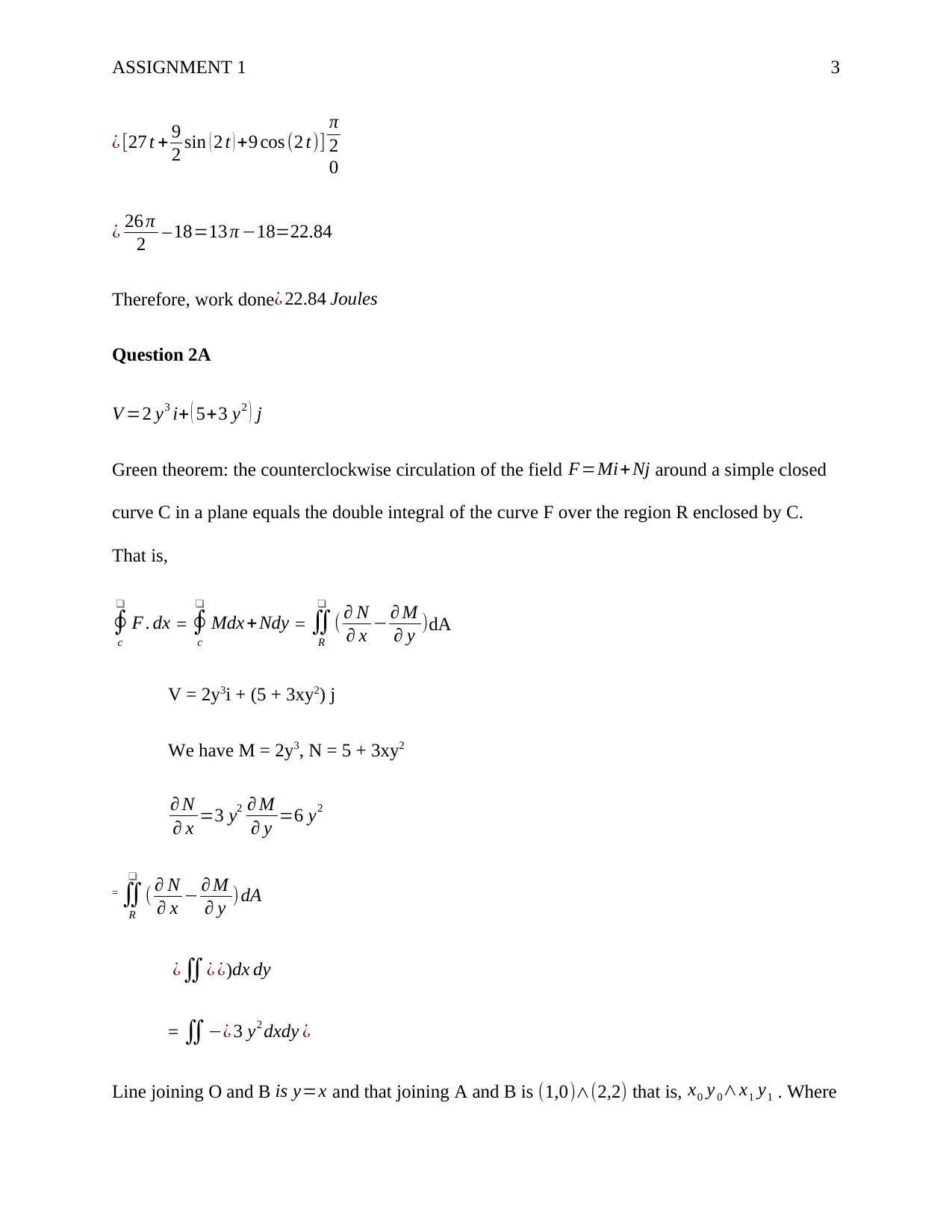
ASSIGNMENT 1 3
¿ [27 t + 9
2 sin ( 2 t ) +9 cos (2 t)]
π
2
0
¿ 26 π
2 – 18=13 π −18=22.84
Therefore, work done¿ 22.84 Joules
Question 2A
V =2 y3 i+ ( 5+3 y2 ) j
Green theorem: the counterclockwise circulation of the field F=Mi+Nj around a simple closed
curve C in a plane equals the double integral of the curve F over the region R enclosed by C.
That is,
∮
c
❑
F . dx = ∮
c
❑
Mdx+Ndy = ∬
R
❑
( ∂ N
∂ x − ∂ M
∂ y )dA
V = 2y3i + (5 + 3xy2) j
We have M = 2y3, N = 5 + 3xy2
∂ N
∂ x =3 y2 ∂ M
∂ y =6 y2
= ∬
R
❑
( ∂ N
∂ x − ∂ M
∂ y ) dA
¿∬¿ ¿)dx dy
= ∬−¿ 3 y2 dxdy ¿
Line joining O and B is y=x and that joining A and B is (1,0)∧(2,2) that is, x0 y 0∧x1 y1 . Where
¿ [27 t + 9
2 sin ( 2 t ) +9 cos (2 t)]
π
2
0
¿ 26 π
2 – 18=13 π −18=22.84
Therefore, work done¿ 22.84 Joules
Question 2A
V =2 y3 i+ ( 5+3 y2 ) j
Green theorem: the counterclockwise circulation of the field F=Mi+Nj around a simple closed
curve C in a plane equals the double integral of the curve F over the region R enclosed by C.
That is,
∮
c
❑
F . dx = ∮
c
❑
Mdx+Ndy = ∬
R
❑
( ∂ N
∂ x − ∂ M
∂ y )dA
V = 2y3i + (5 + 3xy2) j
We have M = 2y3, N = 5 + 3xy2
∂ N
∂ x =3 y2 ∂ M
∂ y =6 y2
= ∬
R
❑
( ∂ N
∂ x − ∂ M
∂ y ) dA
¿∬¿ ¿)dx dy
= ∬−¿ 3 y2 dxdy ¿
Line joining O and B is y=x and that joining A and B is (1,0)∧(2,2) that is, x0 y 0∧x1 y1 . Where
⊘ This is a preview!⊘
Do you want full access?
Subscribe today to unlock all pages.

Trusted by 1+ million students worldwide
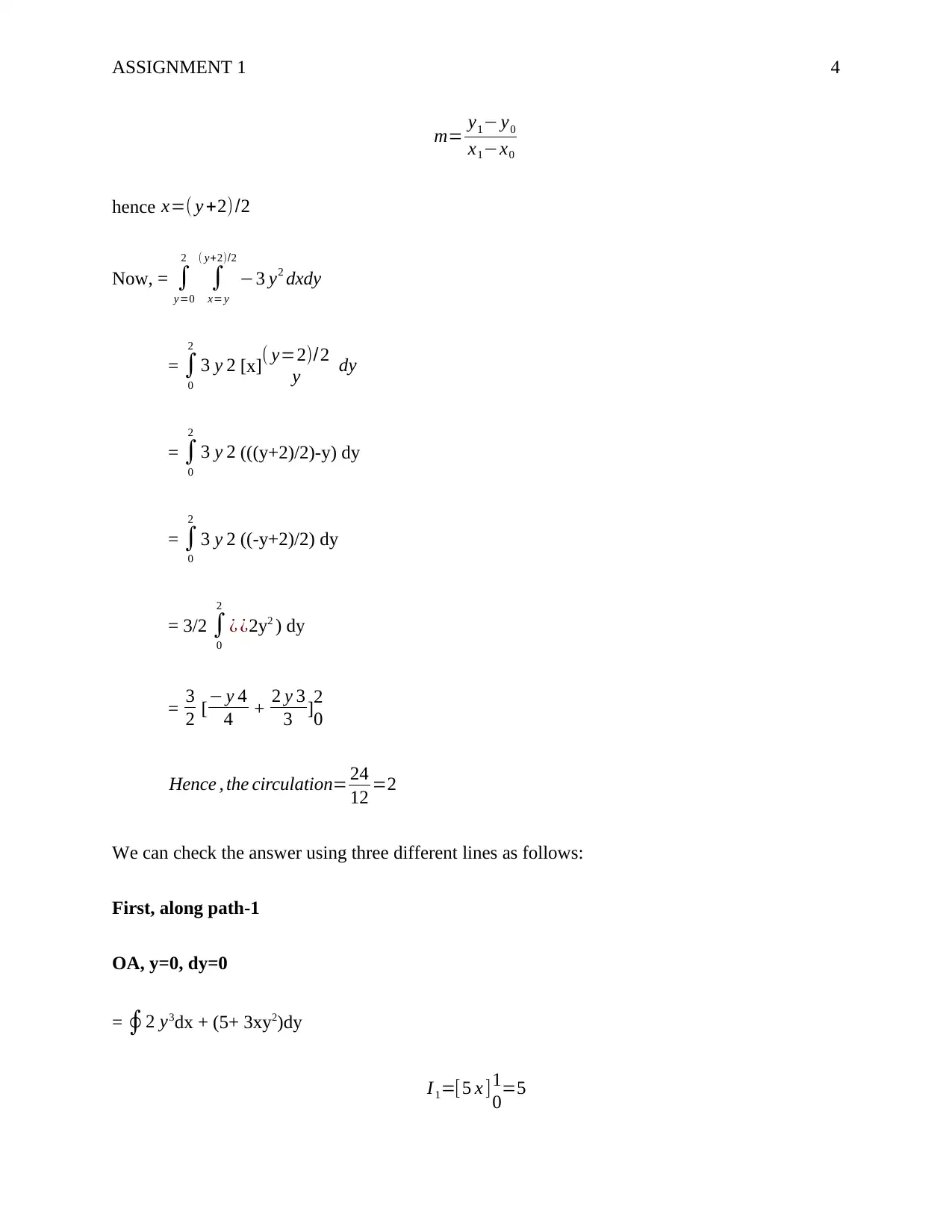
ASSIGNMENT 1 4
m= y1− y0
x1−x0
hence x=( y +2)/2
Now, = ∫
y=0
2
∫
x= y
( y+2)/2
−3 y2 dxdy
= ∫
0
2
3 y 2 [x]
( y=2)/2
y dy
= ∫
0
2
3 y 2 (((y+2)/2)-y) dy
= ∫
0
2
3 y 2 ((-y+2)/2) dy
= 3/2 ∫
0
2
¿ ¿2y2 ) dy
= 3
2 [− y 4
4 + 2 y 3
3 ]
2
0
Hence , the circulation= 24
12 =2
We can check the answer using three different lines as follows:
First, along path-1
OA, y=0, dy=0
= ∮2 y3dx + (5+ 3xy2)dy
I1=[5 x ]1
0=5
m= y1− y0
x1−x0
hence x=( y +2)/2
Now, = ∫
y=0
2
∫
x= y
( y+2)/2
−3 y2 dxdy
= ∫
0
2
3 y 2 [x]
( y=2)/2
y dy
= ∫
0
2
3 y 2 (((y+2)/2)-y) dy
= ∫
0
2
3 y 2 ((-y+2)/2) dy
= 3/2 ∫
0
2
¿ ¿2y2 ) dy
= 3
2 [− y 4
4 + 2 y 3
3 ]
2
0
Hence , the circulation= 24
12 =2
We can check the answer using three different lines as follows:
First, along path-1
OA, y=0, dy=0
= ∮2 y3dx + (5+ 3xy2)dy
I1=[5 x ]1
0=5
Paraphrase This Document
Need a fresh take? Get an instant paraphrase of this document with our AI Paraphraser
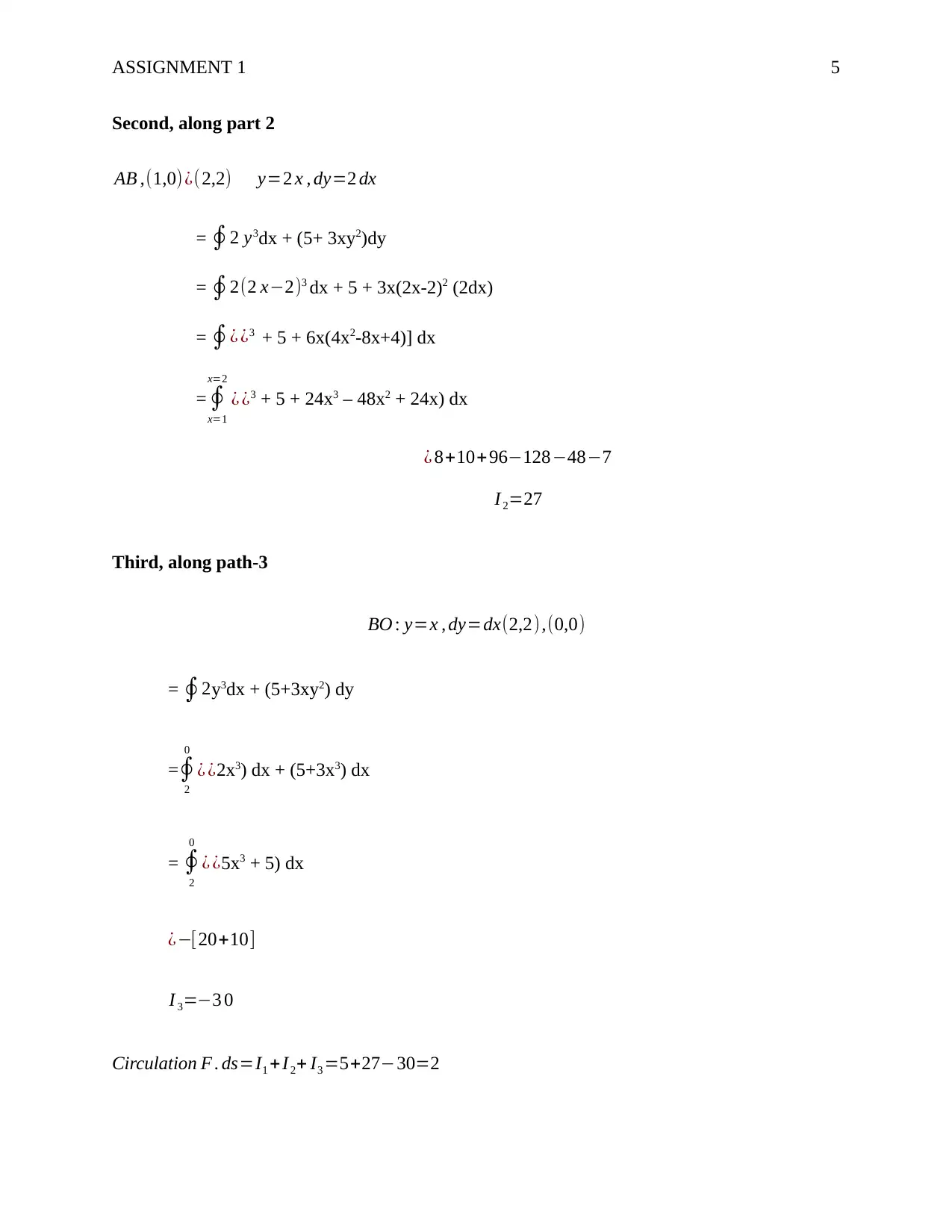
ASSIGNMENT 1 5
Second, along part 2
AB ,(1,0) ¿(2,2) y=2 x , dy=2 dx
= ∮2 y3dx + (5+ 3xy2)dy
= ∮2(2 x−2)3 dx + 5 + 3x(2x-2)2 (2dx)
= ∮¿ ¿3 + 5 + 6x(4x2-8x+4)] dx
= ∮
x=1
x=2
¿ ¿3 + 5 + 24x3 – 48x2 + 24x) dx
¿ 8+10+96−128−48−7
I 2=27
Third, along path-3
BO : y=x , dy=dx(2,2),(0,0)
= ∮2y3dx + (5+3xy2) dy
=∮
2
0
¿ ¿2x3) dx + (5+3x3) dx
= ∮
2
0
¿ ¿5x3 + 5) dx
¿−[20+10]
I 3=−3 0
Circulation F . ds=I1 +I2+ I3 =5+27−30=2
Second, along part 2
AB ,(1,0) ¿(2,2) y=2 x , dy=2 dx
= ∮2 y3dx + (5+ 3xy2)dy
= ∮2(2 x−2)3 dx + 5 + 3x(2x-2)2 (2dx)
= ∮¿ ¿3 + 5 + 6x(4x2-8x+4)] dx
= ∮
x=1
x=2
¿ ¿3 + 5 + 24x3 – 48x2 + 24x) dx
¿ 8+10+96−128−48−7
I 2=27
Third, along path-3
BO : y=x , dy=dx(2,2),(0,0)
= ∮2y3dx + (5+3xy2) dy
=∮
2
0
¿ ¿2x3) dx + (5+3x3) dx
= ∮
2
0
¿ ¿5x3 + 5) dx
¿−[20+10]
I 3=−3 0
Circulation F . ds=I1 +I2+ I3 =5+27−30=2
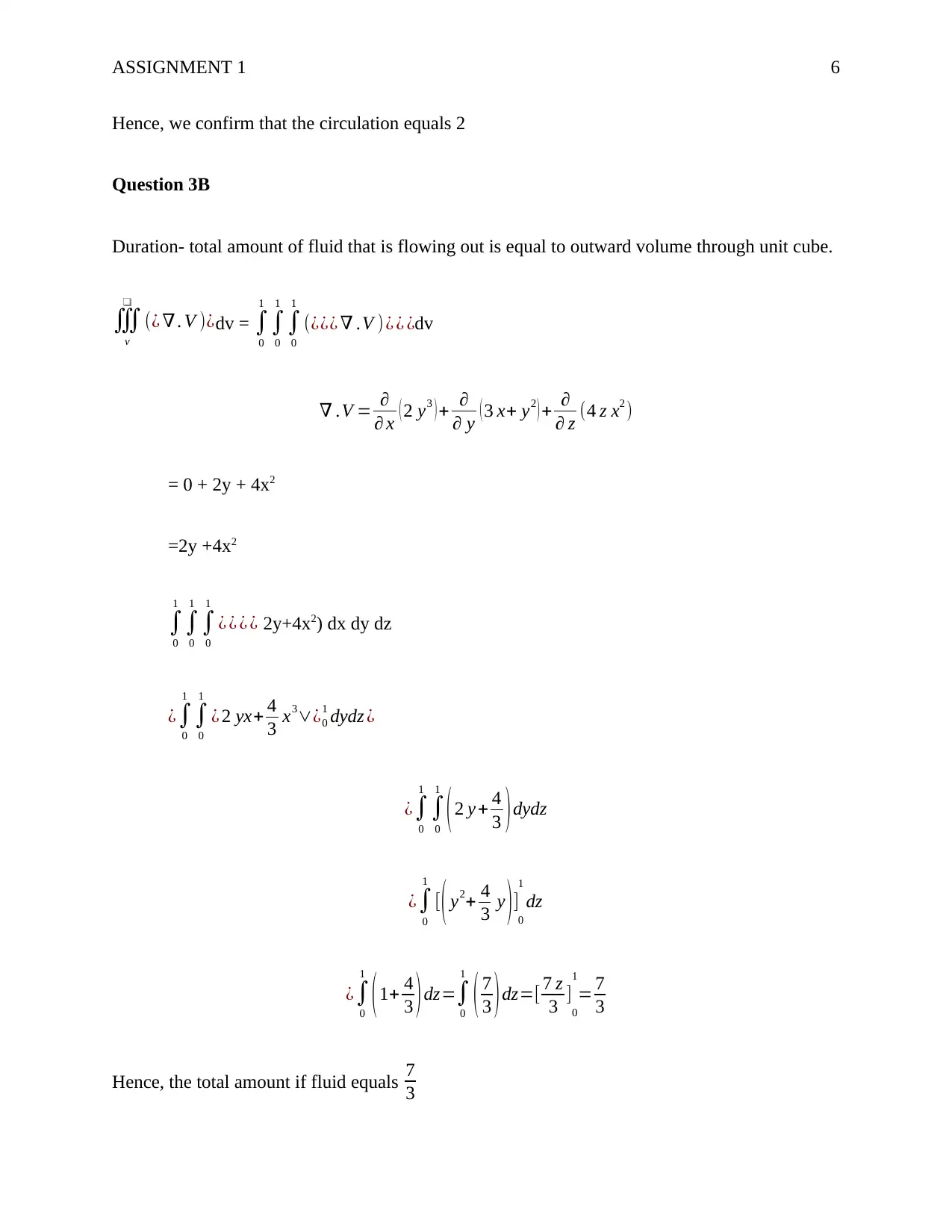
ASSIGNMENT 1 6
Hence, we confirm that the circulation equals 2
Question 3B
Duration- total amount of fluid that is flowing out is equal to outward volume through unit cube.
∭
v
❑
(¿ ∇ . V )¿dv = ∫
0
1
∫
0
1
∫
0
1
(¿¿¿ ∇ .V ) ¿ ¿ ¿dv
∇ .V = ∂
∂ x ( 2 y3 ) + ∂
∂ y ( 3 x+ y2 ) + ∂
∂ z (4 z x2 )
= 0 + 2y + 4x2
=2y +4x2
∫
0
1
∫
0
1
∫
0
1
¿ ¿ ¿ ¿ 2y+4x2) dx dy dz
¿∫
0
1
∫
0
1
¿ 2 yx+ 4
3 x3∨¿0
1 dydz ¿
¿∫
0
1
∫
0
1
( 2 y + 4
3 ) dydz
¿∫
0
1
[ ( y2+ 4
3 y ) ]0
1
dz
¿∫
0
1
( 1+ 4
3 ) dz=∫
0
1
( 7
3 ) dz=[ 7 z
3 ]0
1
= 7
3
Hence, the total amount if fluid equals 7
3
Hence, we confirm that the circulation equals 2
Question 3B
Duration- total amount of fluid that is flowing out is equal to outward volume through unit cube.
∭
v
❑
(¿ ∇ . V )¿dv = ∫
0
1
∫
0
1
∫
0
1
(¿¿¿ ∇ .V ) ¿ ¿ ¿dv
∇ .V = ∂
∂ x ( 2 y3 ) + ∂
∂ y ( 3 x+ y2 ) + ∂
∂ z (4 z x2 )
= 0 + 2y + 4x2
=2y +4x2
∫
0
1
∫
0
1
∫
0
1
¿ ¿ ¿ ¿ 2y+4x2) dx dy dz
¿∫
0
1
∫
0
1
¿ 2 yx+ 4
3 x3∨¿0
1 dydz ¿
¿∫
0
1
∫
0
1
( 2 y + 4
3 ) dydz
¿∫
0
1
[ ( y2+ 4
3 y ) ]0
1
dz
¿∫
0
1
( 1+ 4
3 ) dz=∫
0
1
( 7
3 ) dz=[ 7 z
3 ]0
1
= 7
3
Hence, the total amount if fluid equals 7
3
⊘ This is a preview!⊘
Do you want full access?
Subscribe today to unlock all pages.

Trusted by 1+ million students worldwide
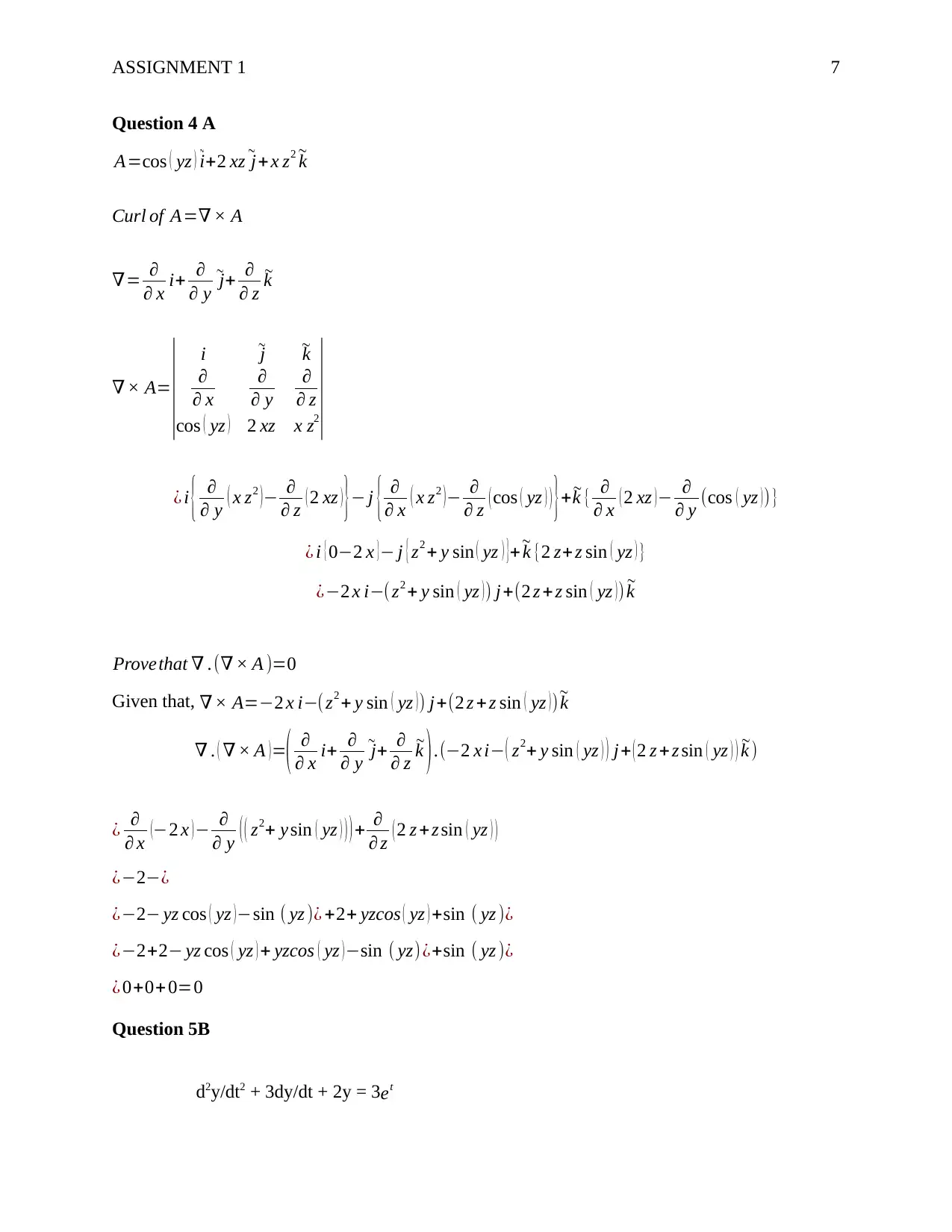
ASSIGNMENT 1 7
Question 4 A
A=cos ( yz ) ~
i+2 xz ~
j+ x z2 ~
k
Curl of A=∇ × A
∇= ∂
∂ x i+ ∂
∂ y
~
j+ ∂
∂ z
~
k
∇ × A=
| i ~
j ~
k
∂
∂ x
∂
∂ y
∂
∂ z
cos ( yz ) 2 xz x z2|
¿ i { ∂
∂ y ( x z2 )− ∂
∂ z ( 2 xz ) }− j { ∂
∂ x ( x z2 )− ∂
∂ z ( cos ( yz ) ) }+ ~
k { ∂
∂ x ( 2 xz )− ∂
∂ y (cos ( yz ))}
¿ i { 0−2 x }− j { z2 + y sin ( yz ) }+ ~
k {2 z+z sin ( yz ) }
¿−2 x i−(z2 + y sin ( yz )) j+(2 z + z sin ( yz )) ~
k
Provethat ∇ .(∇ × A )=0
Given that, ∇ × A=−2 x i−( z2 + y sin ( yz )) j+(2 z +z sin ( yz )) ~
k
∇ . ( ∇ × A )=( ∂
∂ x i+ ∂
∂ y
~
j+ ∂
∂ z
~
k ).(−2 x i− ( z2+ y sin ( yz ) ) j+ ( 2 z +z sin ( yz ) ) ~
k )
¿ ∂
∂ x (−2 x )− ∂
∂ y ( ( z2+ y sin ( yz ) ) ) + ∂
∂ z ( 2 z + z sin ( yz ) )
¿−2−¿
¿−2− yz cos ( yz )−sin ( yz )¿ +2+ yzcos ( yz ) +sin ( yz )¿
¿−2+2− yz cos ( yz ) + yzcos ( yz )−sin ( yz)¿+sin ( yz )¿
¿ 0+0+0=0
Question 5B
d2y/dt2 + 3dy/dt + 2y = 3et
Question 4 A
A=cos ( yz ) ~
i+2 xz ~
j+ x z2 ~
k
Curl of A=∇ × A
∇= ∂
∂ x i+ ∂
∂ y
~
j+ ∂
∂ z
~
k
∇ × A=
| i ~
j ~
k
∂
∂ x
∂
∂ y
∂
∂ z
cos ( yz ) 2 xz x z2|
¿ i { ∂
∂ y ( x z2 )− ∂
∂ z ( 2 xz ) }− j { ∂
∂ x ( x z2 )− ∂
∂ z ( cos ( yz ) ) }+ ~
k { ∂
∂ x ( 2 xz )− ∂
∂ y (cos ( yz ))}
¿ i { 0−2 x }− j { z2 + y sin ( yz ) }+ ~
k {2 z+z sin ( yz ) }
¿−2 x i−(z2 + y sin ( yz )) j+(2 z + z sin ( yz )) ~
k
Provethat ∇ .(∇ × A )=0
Given that, ∇ × A=−2 x i−( z2 + y sin ( yz )) j+(2 z +z sin ( yz )) ~
k
∇ . ( ∇ × A )=( ∂
∂ x i+ ∂
∂ y
~
j+ ∂
∂ z
~
k ).(−2 x i− ( z2+ y sin ( yz ) ) j+ ( 2 z +z sin ( yz ) ) ~
k )
¿ ∂
∂ x (−2 x )− ∂
∂ y ( ( z2+ y sin ( yz ) ) ) + ∂
∂ z ( 2 z + z sin ( yz ) )
¿−2−¿
¿−2− yz cos ( yz )−sin ( yz )¿ +2+ yzcos ( yz ) +sin ( yz )¿
¿−2+2− yz cos ( yz ) + yzcos ( yz )−sin ( yz)¿+sin ( yz )¿
¿ 0+0+0=0
Question 5B
d2y/dt2 + 3dy/dt + 2y = 3et
Paraphrase This Document
Need a fresh take? Get an instant paraphrase of this document with our AI Paraphraser
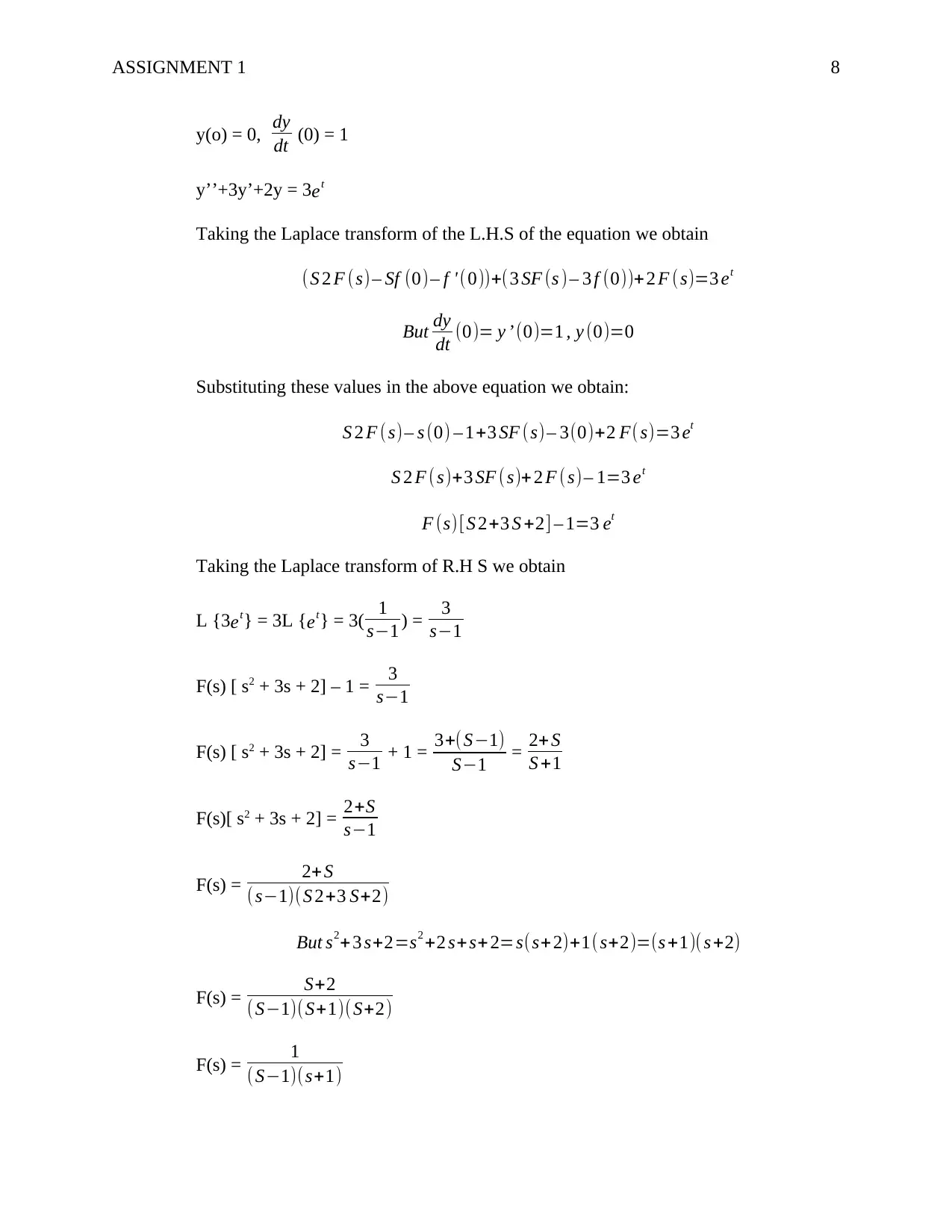
ASSIGNMENT 1 8
y(o) = 0, dy
dt (0) = 1
y’’+3y’+2y = 3et
Taking the Laplace transform of the L.H.S of the equation we obtain
(S 2 F (s)– Sf (0)– f ' (0))+(3 SF (s )– 3 f (0))+ 2 F (s)=3 et
But dy
dt (0)= y ’ (0)=1 , y (0)=0
Substituting these values in the above equation we obtain:
S 2 F (s)– s (0) – 1+3 SF (s) – 3(0)+2 F( s)=3 et
S 2 F ( s)+3 SF ( s)+2 F ( s)– 1=3 et
F (s)[S 2+3 S +2] – 1=3 et
Taking the Laplace transform of R.H S we obtain
L {3et} = 3L {et} = 3( 1
s−1 ) = 3
s−1
F(s) [ s2 + 3s + 2] – 1 = 3
s−1
F(s) [ s2 + 3s + 2] = 3
s−1 + 1 = 3+(S−1)
S−1 = 2+ S
S +1
F(s)[ s2 + 3s + 2] = 2+S
s−1
F(s) = 2+S
( s−1)(S 2+3 S+2)
But s2+3 s+2=s2 +2 s+s+ 2=s(s+2)+1( s+2)=(s +1)( s +2)
F(s) = S+2
( S−1)(S+1)( S+2)
F(s) = 1
( S−1)(s+1)
y(o) = 0, dy
dt (0) = 1
y’’+3y’+2y = 3et
Taking the Laplace transform of the L.H.S of the equation we obtain
(S 2 F (s)– Sf (0)– f ' (0))+(3 SF (s )– 3 f (0))+ 2 F (s)=3 et
But dy
dt (0)= y ’ (0)=1 , y (0)=0
Substituting these values in the above equation we obtain:
S 2 F (s)– s (0) – 1+3 SF (s) – 3(0)+2 F( s)=3 et
S 2 F ( s)+3 SF ( s)+2 F ( s)– 1=3 et
F (s)[S 2+3 S +2] – 1=3 et
Taking the Laplace transform of R.H S we obtain
L {3et} = 3L {et} = 3( 1
s−1 ) = 3
s−1
F(s) [ s2 + 3s + 2] – 1 = 3
s−1
F(s) [ s2 + 3s + 2] = 3
s−1 + 1 = 3+(S−1)
S−1 = 2+ S
S +1
F(s)[ s2 + 3s + 2] = 2+S
s−1
F(s) = 2+S
( s−1)(S 2+3 S+2)
But s2+3 s+2=s2 +2 s+s+ 2=s(s+2)+1( s+2)=(s +1)( s +2)
F(s) = S+2
( S−1)(S+1)( S+2)
F(s) = 1
( S−1)(s+1)
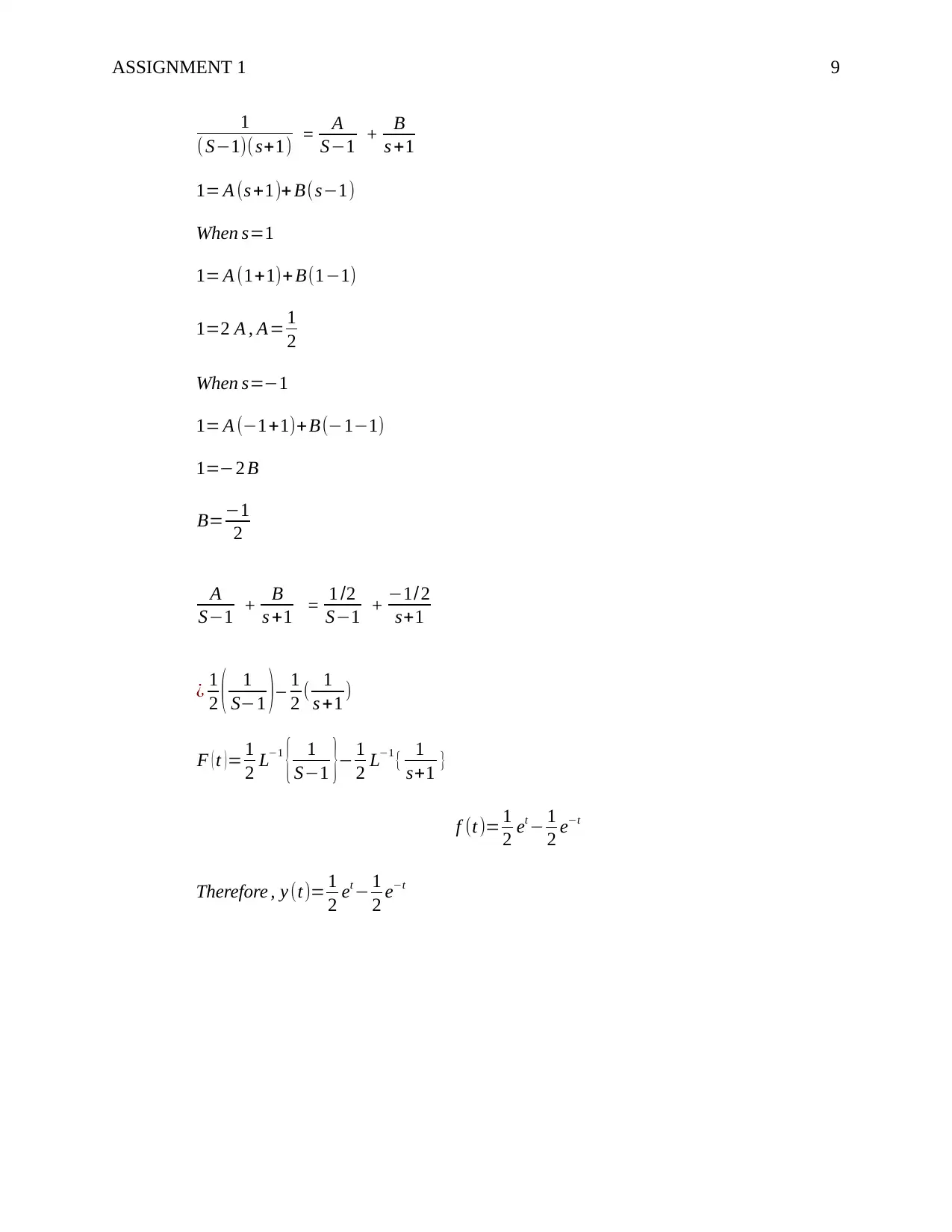
ASSIGNMENT 1 9
1
( S−1)(s+1) = A
S−1 + B
s +1
1= A (s +1)+ B(s−1)
When s=1
1= A (1+1)+ B(1−1)
1=2 A , A= 1
2
When s=−1
1= A (−1+1)+ B(−1−1)
1=−2 B
B=−1
2
A
S−1 + B
s +1 = 1 /2
S−1 + −1/2
s+1
¿ 1
2 ( 1
S−1 ) – 1
2 ( 1
s +1 )
F ( t )= 1
2 L−1
{ 1
S−1 }− 1
2 L−1 { 1
s+1 }
f (t )= 1
2 et − 1
2 e−t
Therefore , y (t)= 1
2 et − 1
2 e−t
1
( S−1)(s+1) = A
S−1 + B
s +1
1= A (s +1)+ B(s−1)
When s=1
1= A (1+1)+ B(1−1)
1=2 A , A= 1
2
When s=−1
1= A (−1+1)+ B(−1−1)
1=−2 B
B=−1
2
A
S−1 + B
s +1 = 1 /2
S−1 + −1/2
s+1
¿ 1
2 ( 1
S−1 ) – 1
2 ( 1
s +1 )
F ( t )= 1
2 L−1
{ 1
S−1 }− 1
2 L−1 { 1
s+1 }
f (t )= 1
2 et − 1
2 e−t
Therefore , y (t)= 1
2 et − 1
2 e−t
⊘ This is a preview!⊘
Do you want full access?
Subscribe today to unlock all pages.

Trusted by 1+ million students worldwide
1 out of 9
Related Documents
Your All-in-One AI-Powered Toolkit for Academic Success.
+13062052269
info@desklib.com
Available 24*7 on WhatsApp / Email
![[object Object]](/_next/static/media/star-bottom.7253800d.svg)
Unlock your academic potential
Copyright © 2020–2025 A2Z Services. All Rights Reserved. Developed and managed by ZUCOL.





